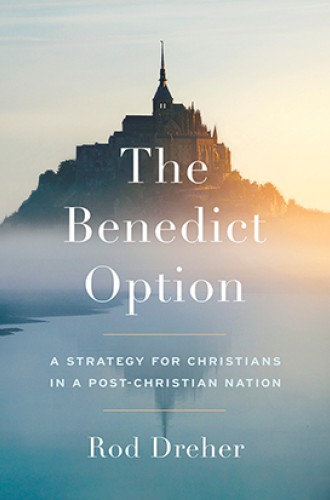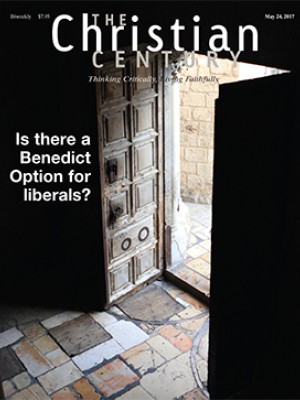Who is the Benedict Option for?
Rod Dreher calls on Christians to form deeper, more distinct communities. This should sound familiar to liberals.
Rod Dreher’s The Benedict Option touches on an array of subjects, from the decline of the Christian West to the atomizing effects of smartphones to the competing rights claims of same-sex couples and evangelical bakers. It does this in tones pitched variously to inform, to motivate, or to air grievance. So there is ample opportunity for readers to be distracted from Dreher’s overall purposes, as indeed many have been—interpreting The Benedict Option as either a political tract against same-sex marriage or a separatist call to take to the hills. Both readings are there for the proof-texter’s picking; neither attends to the deeper vision of this provocative book.
To do that, you have to appreciate who the book is for. It is not aimed at conservative political activists, though its publisher is known for just that. It doesn’t target radicals who aspire to rarified modes of Christian community, though Dreher finds much to admire there. Nor is it meant to enlighten spiritual seekers or the social scientists who study them.
Read our latest issue or browse back issues.
No, Dreher writes for the church and the ordinary Christians in it. He sees existential threats to the faith—from without but especially from within, where bonds are frayed and formation is thin. Inspired by the well-known ending of Alasdair MacIntyre’s After Virtue, Dreher looks to St. Benedict for a survival plan. How can the church build the internal strength it needs?
To be sure, the problem Dreher is addressing isn’t just pews that are vacant three Sundays a month and halfheartedly occupied the fourth. It’s the broader cultural context: the West’s sacral imagination long since displaced by nominalism, the triumph of individual desire as an ethic, the loosening of communal ties of all kinds, the way moral therapeutic deism functions as priest to all this and rarely prophet. Dreher, a self-described pessimist, presents a case that church and culture have colluded in their own mutual, steady decline.
Yet his solution isn’t about saving the world. It’s about rebuilding the church, for its own sake first and then for the sake of the world. It’s about creating thick, resilient Christian communities, as Benedict did, that will serve the world by their very existence—by the way they form their members as Christians and as humans.
This requires deeper roots in everything that makes Christianity distinct. Dreher calls for a recovery of sacramental worship in all its strangeness, over and against the instinct to meet culture where it’s at. Christians have a unique story, and they need to learn to tell it—first of all to themselves. Above all they need to be faithful disciples, before being patriotic Americans or tolerant global citizens or anything else.
This means—to take one example—refusing to bow to the gods of technological progress. Dreher critiques the dominant instrumentalist view that technology is morally neutral, a mere tool to use for good or ill. No, he says, technology trains us to believe that “if we can do it, we must be free to do it.” This is an important insight. The deep libertarianism of Silicon Valley is not a coincidence; it’s a worldview shaped by tech itself and promulgated by a business elite whose products have colonized our lives. It’s become clear that our gadgets give us ever more freedom to do anything our socially isolated little hearts desire—except stop using them. To Dreher, the ascendance of this techno-worldview is an indictment of liberalism and a poison for the church.
Dreher emphasizes, however, that the Benedict Option is not just about rejecting the bad, technological or otherwise. It’s about cultivating the good; it’s resistance by way of creation. Dreher is at his best when he is constructive and concrete, and his chapter explicating Benedict’s Rule for 21st-century laypeople is perhaps his most compelling. Cultivating the good means seeing God’s presence in the everyday, in mundane routine. Anxious people are “looking for that ‘killer app’ that will make everything right again”; Benedictine life shows another way. Develop a discipline of prayer. Let your approach to work flow out of that prayer. Grow roots in a place, among a people. Go to church, and linger afterward—be a pilgrim, not a tourist.
Our lives are inevitably centered on something, says Dreher, and it requires daily practice to ensure that something is Christ. So the most pressing task for Christians is to embed themselves in the day-to-day life of Christian community. And wherever thick Christian ways of life do not exist, they will simply have to be built, one local, unglamorous piece at a time.
This doesn’t mean turning a blind eye to national politics, but it does mean giving it less relative emphasis. If the Benedict Option is a withdrawal strategy, it’s one of priority, not principle. It’s not that public life has no value, only that time is limited and other things matter more: Christian culture and community, a faithful alternative to the reigning order.
This will all sound quite familiar to most mainline Protestant church leaders, and quite compelling to a lot of them. Dreher’s themes echo the postliberal theology popularized by, among others, Stanley Hauerwas and Will Willimon. Their thinking has met some resistance in the mainline, but it has also deeply shaped it—especially the distrust many of us have for the imperial state, our refusal to cede the high christological ground to evangelicals, and our localist-communitarian ideals. (The Century’s inbox of article submissions contains enough quotes from Wendell Berry for us editors to joke about imposing a moratorium.)
Meanwhile, the liturgical reforms of the Second Vatican Council have deeply influenced worship renewal among liberal Protestants. While traditionalist Catholics don’t tend to see the council’s reforms in a positive light, it’s easy for them to miss the fact that on the Protestant side, the broad postconciliar trajectory has been toward tradition at least as much as away from it. Liberal churches aren’t just singing social justice songs about a gender-neutral God. Many are recentering their worship life around weekly communion; some are also recovering the Easter vigil and other baptismal festivals, maybe even the catechumenate. Churches are looking to tradition as they work to form thicker, more deeply sacramental worshiping communities.
These decades-long trends haven’t captured the entire mainline. But nor are they mere footnotes. So as a mainline Protestant it’s a bit jarring to read Dreher, practically taste his enthusiasm for Christian community and liturgy, and yet recognize that there’s at least one more group he isn’t writing for: us.
The Benedict Option is aimed at conservative Christians, not Christians generally. While the rest of us may find a lot to like here, the feeling doesn’t seem to be mutual. Dreher—who as a Methodist turned Catholic turned Orthodox is a rather self-conscious ecumenist—claims early on that the Benedict Option is accessible to “all churches and confessions.” But elsewhere he’s pretty clear that he doesn’t really mean all of them. He means the ones he deems correct.
Dreher spells out a more or less linear path of corruption, an orthodox faith accommodating itself to secular modernity. In this telling, the more liberal churches appear only as a cautionary tale, a glimpse of the fate that lies around the bend. Dreher, of course, departs from many religious conservatives in acknowledging that cultural accommodation is a problem on that side of the church aisle at all. But his narrative leaves little space to consider whether the problem might look qualitatively different in a liberal context rather than simply worse.
This kind of linear thinking pervades The Benedict Option. Dreher does acknowledge that modernity brought some good with the bad, and he explicitly disavows any longing to turn back the clock. But disclaimers aside, he persistently views the church and the culture through a lens of linear decline. Communitarianism is displaced by rank individualism; traditional restraints steadily crumble until nothing remains and anything goes.
At our best, more progressive Christians don’t take the inverse view of this classic traditionalist one. Instead, we recognize that the whole framework is too tidy. After all, tradition and progress are both good things—and sometimes oppressively bad ones. Community matters more than just about anything—except maybe human dignity, which can flourish in community but can also be undermined by it. Life together can indeed help us smash late modernity’s idol of individual desire. But what about community’s tendency to nurture the desire to stamp out difference?
In short, what’s at stake here is not simply a choice between cultural accommodation and Dreher’s call to “form a vibrant counterculture.” There is also the question of discernment. Christians do have a norm that is far higher than any whim of culture or politics or techno-futurist progress. But that norm isn’t tradition; it’s the gospel. And while faithfulness to this gospel will surely put us at odds with contemporary culture, it will also put us at odds with our own Christian past. The hard part is knowing when.
To a traditionalist like Dreher, this sort of appeal to discernment might look like a smokescreen for doctrinal anarchy. It isn’t. It’s an effort to take seriously the Holy Spirit’s work forming community from the bottom up, in particular places at particular times. A community that discerns that Spirit together won’t mirror the wider culture’s values, but neither will it replicate the values of the old power structures. It will be a people both peculiar and perpetually made new.
Unfortunately, the notion that a church’s more liberal values might come from a theologically constructive place, as opposed to a culturally accommodated one, lies outside Dreher’s grand linear narrative. This comes up most concretely in his section on same-sex marriage. Dreher sees same-sex marriage as one of many stops on the sexual revolution train, part of a cultural sea change that has reinvented the fundamental purpose of sex. In opposing it, he appeals to scripture, natural law, and the weight of tradition. He commends those gay and lesbian Christians who eschew marriage and embrace celibacy instead.
For Dreher, same-sex marriage is more symptom than cause; opposing it is not the Benedict Option’s purpose. But it is most certainly a litmus test. Holding the line on marriage represents a “core teaching of the Christian faith,” Dreher says, and there is “perhaps none more important to obey.” (Really? None?) Dreher calls the Supreme Court’s Obergefell v. Hodges decision a Waterloo for religious conservatives: the sexual revolution won.
Yet his underlying theological points say more about why marriage is good than why it should only be for straight people. The incarnation, says Dreher, means that the way we treat our bodies profoundly matters. Yes, 100 times! But is there no daylight between something mattering and its mattering in exactly the way we’ve perceived it to matter before? Citing Olivier Clément, Dreher claims that in Christianity, eros is transformed into agape. Eugene Rogers has said the same in the Century (“Same-sex complementarity,” May 11, 2011). I wonder what Dreher would make of something else Rogers says: that marriage is for sanctification, and same-sex couples need to be made holy, too.
Probably he’d make nothing of it—Dreher shows little interest in theological accounts of same-sex marriage as actually practiced by real-life Christians. The topic functions instead as a proxy for the larger cultural tsunami he sees crashing into a church with no levees. Fine. But he’s wrong to write off all Christian embraces of same-sex marriage as cultural accommodation “for the sake of keeping Millennials.” Same-sex couples and their allies are not some demographic group that a separately defined group of church leaders needs to make decisions for and about. They’re among us; they are us. And together, we seek to discern the gospel’s demands and the Spirit’s movement. There is deep conviction here, and serious theological work being done.
Perhaps someone else will need to articulate a progressive Benedict Option, a separate project parallel to Dreher’s. Richard Beck has developed some thoughts on this on his Experimental Theology blog. Beck’s main point is that while Dreher emphasizes Christian culture—institutions, orthodoxy, piety, liturgy—progressive Christians should instead prioritize cruciformity: formation in the cross for the care of others. “Rod’s BenOp is inspired by medieval monasticism,” he writes, “where the BenOp I’m describing is inspired by the gospels.”
As Beck acknowledges, the two are hardly mutually exclusive. Conservative Christians can and do devote themselves to self-giving service, though this isn’t Dreher’s focus. I’d add that liberals can be and are formed for Christian communities in which tradition speaks but doesn’t hog the mic, in which theology and piety aren’t preserved in amber yet do matter, deeply.
So while I’d be glad to see Dreher’s Benedict Option thrive among conservatives, and even gladder to see a liberal option to the Option thrive alongside it, I still hope for something even more outrageous: that we may all somehow be one. As long as we’re hoping, let’s hope for a rebirth of thick Christian community that is broadly, generously ecumenical, that plants its deepest roots neither in received tradition nor in dreams of progress but in the gospel of the living God.
A version of this article appears in the May 24 print edition under the title “Deep roots, open doors.”








